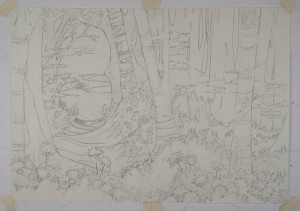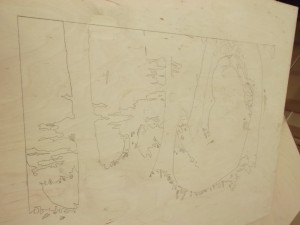I like Brian Cox with his hair and his enthusiasm for describing the Cosmos with the help of an empty beer bottle and a stick, but I was very sorry to hear him dismiss art in favour of science*. If I ruled the world (though better hope I don’t because there would be laws against leaving lights on in empty rooms and the airing of Count Arthur Strong on the radio, ever…) I’d just lump everything under the collective heading of ‘creativity’ and be done with dividing the arts and sciences.
Today I have been mapping out my latest print and it raised a philosophical question for me: was the process art or science? The print is a complex one: a view from inside a shady spring wood out over a bright spring landscape and I confess I did have to switch off Radio Four to concentrate. I’ll describe the process and you decide what was actually going on – maths, art, physics, alchemy?

I begin with a line drawing of the whole image. This I use to trace the separate parts of the design onto wood, creating multiple woodblocks (a block being the area that gets printed, not the whole piece of wood). Each block is printed in turn to form the finished image.
If it were just a matter of splitting the design into a block for each tree, patch of grass, field etc it would simple. However, I am exploiting the fact that I am working with transparent watercolour and can layer washes of colour to build up the image. This is irrespective of the different areas of the design, so the blue of the sky can also be used to create the blue shadows in the wood by cutting a block the full size of the print rather than one the size of the sky. Likewise I can play with building the depth and texture of the grasses and trees by what print surface I leave and what I remove; cutting blocks covering large areas of the print rather than specific subjects. I ink up the woodblocks with brushes, not rollers, so each block can be inked solid, or with bleeds or mixes of colour.
To work this out I hold the image in full colour in my head. Then I mentally pull it apart, like old fashioned animation, into its separate layers of colours and visualise how layers one to fifteen (it’s a big complicated print) look alone and then together in various combinations so that I can work out what part can be printed with one block and what part will benefit from several blocks printed over each other, where the shadows should be deep or sun should dapple etc. Then I delve into my experience of the paper and paints I plan on using, mentally running through how the pigments will actually work (some resist layering and others accommodate it) and what the paper can stand in terms of pressure, over printing and time spent damp. Then I start tracing, making adjustments and changes as I go.

Now I seriously think about it, my process (all art has processes and I’m nothing special) doesn’t fit neatly into ‘art’ and I bet scientist would say the same about themselves. So while you can play the ‘is it art or science’ game with the results of all our labours, isn’t that a bit pointless? Wouldn’t it just be better to mix everything together and value the creativity? I worry about our politicians and their need to push science over art at present. So perhaps best if I do take over world domination – when I’ve finished laying down the laws on radio content and unnecessary illumination, I’ll be changing the education system a bit too.
*
He suggested that ‘we can live without art, but we can’t live without science’ which is a whole other argument (perhaps to have with our early ancestors). What interested me was his need to have a division in the first place.
I enjoyed reading your comments and it made me think. I suppose it depends on how you define “live”.
I draw and paint and cannot imagine being unable to. It’s important to me.
Every child has the ability to be “creative” in an inhibited way. Even if you feel that you are not “artistic” you can appreciate art. It can speak to you; make you appreciate beauty in nature; even cause you to question your understanding of things. It’s not just about the mechanics of life, but what can also give your life meaning and pleasure. I agree with you there should be no division. We need both art and science.
I think we have always
You don’t have to know the science of how the eye sees colour but it is much easier to understand how colours work together and what complimentary colours or primary colours are. And I know a lot of people totally bemused by perspective who could do with a little geometry.
On the other hand the creative scientist is searching for different ways to look at things, seeks patterns and sees what others haven’t. Two threads intertwined. We could go on to seeing things in black and white or rival claims of importance of nature/nurture in child rearing…..
I meant uninhibited way, just re-read my post!
Art is art, science is science. People should respect other disciplines and be a bit more humble and a bit less judgemental. The sadness of modern life is that this sort of mutual respect is being lost. We should be proud to be artists and confident in the value of our pursuit. Similarly I am very glad people are looking for new antibiotics!
Your ability to visualise the colours separately and how they will combine is truly amazing. What you describe is not science as I understand it, but then strictly speaking the theory of evolution through natural selection probably isn’t either as it can’t be disproved. If you’re interested in the nature of science Karl Popper is the man to read.
Your opinion of Count Arthur Strong, on the other hand, is lamentable, but then no one’s perfect!
Phil – you stand alone in our bit the family re. A Strong 🙁 but we all still love you x
I have to agree with Laura. I can’t listen to the man.
He can say it all he wants to, but we won’t live without art, even if we wanted to. Art is in everything you look at, from architecture to design, everything required an artist’s concept. Art came before reading in our evolution, and it is part of our nature, see also the most beautiful paintings ever created – the cave paintings. There’s always this desire to put art down, on the part of some types of people, it’s annoying. I don’t believe true scientists think this way about art, in fact they use artists to help with illustrating ideas.
Before cameras, everyone had to learn to draw in school, because they had to, and drawing improves the intellect – maybe he could study the science in how art improves the brain.
It is said “art is a science with more than seven variables”. I think your post proves that, and disproves Brian Cox’s theory.